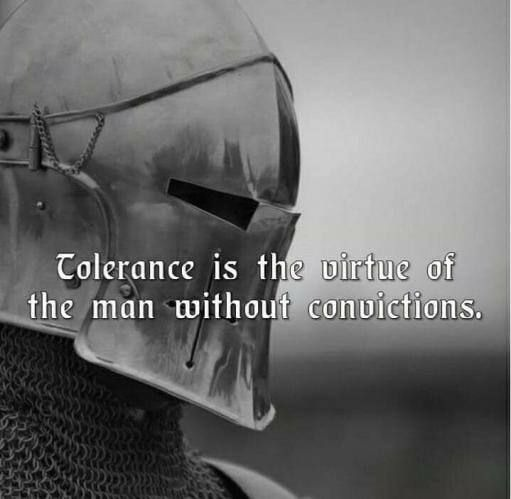None Dare Call It Conspiracy Chapter 6: The Rockefellers and The Reds
The most important American of those "different personages" who run the world from behind the scenes are the Rockefellers. The Rockefeller clan reportedly has worked with the Rothschilds and their agents since the 1880's when the original John D. arranged to get a rebate on every barrel of oil he and his competitors shipped over Kuhn, Loeb & Co.-controlled Pennsylvania and Baltimore & Ohio railroads. It has been a profitable partnership ever since, although there appear to have been areas in which the two financial dynasties competed.
The involvement of the Rockefellers with their supposed blood enemies, the Communists, dates back to the Bolshevik Revolution. During the 1920's Lenin established his New Economic Policy (the same name Mr. Nixon applied to his wage-price control package), when the supposedly hated capitalists were invited back into Russia.
The Federal Reserve-CFR insiders began pushing to open up Communist Russia to U. S. traders soon after the revolution. However, at that time public opinion ran so high against the Bolsheviks because of their barbarism that it was official U. S. government policy not to deal with the outlaw government. The U. S. did not officially recognize the Bolsheviks until 1933. In the meantime, the Soviet economy was in a shambles and the people were starving to death. Communism would have collapsed had it not been aided by the Insiders. The Bolsheviks were originally saved from collapse by Herbert Hoover (CFR) who raised money to buy food which was appropriated by Lenin and his gangsters. They used it as a tool to subdue starving peasants who had been resisting their newly imposed slave masters. While Hoover's "humanitarian" gesture saved the Soviet regime, the Russian economy was still in total chaos. In came the Vanderlips, Harrimans and Rockefellers. One of the first to jump in was Frank Vanderlip, an agent of the Rockefellers and one of the Jekyll Island conspirators, president of the Rockefeller First National City Bank, who compared Lenin to George Washington. (Louis Budenz, The Bolshevik Invasion of The West, Bookmailer, p.115)
The Rockefellers assigned their public relations agent, Ivy Lee, to sell the American public the idea that the Bolsheviks were merely misunderstood idealists who were actually kind benefactors of mankind.
Professor Antony Sutton of Stanford University's Hoover Institution, notes in his highly authoritative Western Technology and Soviet Economic Development:
"Quite predictably, 180 pages later, Lee concludes that the communist problem is merely psychological. By this time he is talking about 'Russians' (not Communists) and concludes 'they are all right.' He suggests the United States should not engage in propaganda; makes a plea for peaceful coexistence; and suggests the United States would find it sound policy to recognize the USSR and advance credits." (Antony Sutton, Western Technology and Soviet Economic Development, 1917-1930, Hoover Institution on War, Revolution and Peace, Stanford University, Calif., 1968, p.292)
After the Bolshevik Revolution, Standard of New Jersey bought 50 per cent of the Nobel's huge Caucasus oil fields even though the property had theoretically been nationalized. (O'Connor, Harvey, The Empire Of Oil, Monthly Review Press, New York, 1955, p.270)
In 1927, Standard Oil of New York built a refinery in Russia, thereby helping the Bolsheviks put their economy back on its feet. Professor Sutton states: "This was the first United States investment in Russia since the Revolution." (Ibid, Vol.1, p.38)
Shortly thereafter Standard Oil of New York and its subsidiary, Vacuum Oil Company, concluded a deal to market Soviet oil in European countries and it was reported that a loan of $75,009,000 to the Bolsheviks was arranged. (National Republic, Sept.1927)
We have been unable to find out if Standard Oil was even theoretically expropriated by the Communists. Sutton writes:
"Only the Danish telegraph concessions, the Japanese fishing, coal and oil concessions, and the Standard Oil lease remained after 1935." (Ibid, Vol.11, p.17)
Wherever Standard Oil would go, Chase National Bank was sure to follow. (The Rockefeller's Chase Bank was later merged with the Warburg's Manhattan Bank to form the present Chase Manhattan Bank.) In order to rescue the Bolsheviks, who were supposedly an archenemy, the Chase National Bank was instrumental in establishing the American-Russian Chamber of Commerce in 1922. President of the Chamber was Reeve Schley, a vice-president of Chase National Bank. (Ibid, Vol.11, p.288) According to Professor Sutton: "In 1925, negotiations between Chase and Prombank extended beyond the finance of raw materials and mapped out a complete program for financing Soviet raw material exports to the U. S. and imports of U. S. cotton and machinery. (Ibid, Vol.11, p.226) Sutton also reports that "Chase National Bank and the Equitable Trust Company were leaders in the Soviet credit business." (Ibid, p.277)
The Rockefeller's Chase National Bank also was involved in selling Bolshevik bonds in the United States in 1928. Patriotic organizations denounced the Chase as an "international fence." Chase was called "a disgrace to America… They will go to any lengths for a few dollars profits." (Ibid, Vol.11, p.291) Congressman Louis McFadden, chairman of the House Banking Committee, maintained in a speech to his fellow Congressmen:
"The Soviet government has been given United States Treasury funds by the Federal Reserve Board and the Federal Reserve Banks acting through the Chase Bank and the Guaranty Trust Company and other banks in New York City.
Open up the books of Amtorg, the trading organization of the Soviet government in New York, and of Gostorg, the general office of the Soviet Trade Organization, and of the State Bank of the Union of Soviet Socialist Republics and you will be staggered to see how much American money has been taken from the United States' Treasury for the benefit of Russia. Find out what business has been transacted for the State Bank of Soviet Russia by its correspondent, the Chase Bank of New York.
(Congressional Record, June 15, 1933)
But the Rockefellers apparently were not alone in financing the Communist arm of the Insiders' conspiracy. According to Professor Sutton "… there is a report in the State Department files that names Kuhn, Loeb & Co. (the long established and important financial house in New York) as the financier of the First Five Year Plan. See U. S. State Dept. Decimal File, 811.51/3711 and 861.50 FIVE YEAR PLAN/236." (Sutton, op. cit., Vol. II, p. 340n)
Professor Sutton proves conclusively in his three volume history of Soviet technological development that the Soviet Union was almost literally manufactured by the U.S.A. Sutton quotes a report by Averell Harriman to the State Department in June, 1944 as stating:
"Stalin paid tribute to the assistance rendered by the United States to Soviet industry before and during the war. He said that about two-thirds of all the large industrial enterprise in the Soviet Union had been built with United States help or technical assistance." (Sutton, op. cit., Vol.11, p.3)
Remember that this was at a time when the Soviets had already established an extensive spy network in the U.S. and the Communist Daily Worker newspaper regularly called for the destruction of our liberty and the Sovietizing of America.
Sutton shows that there is hardly a segment of the Soviet economy which is not a result of the transference of Western, particularly American, technology.
This cannot be wholly the result of accident. For fifty years the Federal Reserve-CFR-Rockefeller-lnsider crowd has advocated and carried out policies aimed at increasing the power of their satellite, the Soviet Union. Meanwhile, America spends $75 billion a year on defense to protect itself from the enemy the Insiders are building up.
What has been true of the past is even more valid today. The leader in promoting the transfer of technology and increasing aid and trade with the Communists is the Council on Foreign Relations.
On October 7, 1966, President Lyndon Johnson, a man who had appointed a C.F.R. member to virtually every strategic position in his administration, stated:
"We intend to press for legislative authority to negotiate trade agreements which could extend most favored-nation tariff treatment to European Communist states.
We will reduce export controls on East-West trade with respect to hundreds of non-strategic items.
The New York Times reported one week later on October 13, 1966:
"The United States put into effect today one of President Johnson's proposals for stimulating East-West trade by removing restrictions on the export of more than four hundred commodities to the Soviet Union and Eastern Europe.
Among the categories from which items have been selected for export relaxation are vegetables, cereals, fodder, hides, crude and manufactured rubber, pulp and waste paper, textiles and textile fibers, crude fertilizers, metal ores and scrap, petroleum, gas and derivatives, chemical compounds and products, dyes, medicines, fireworks, detergents, plastic materials, metal products and machinery, and scientific and professional instruments."
Virtually every one of these "non-strategic" items has a direct or indirect use in war. Later, items such as rifle cleaning compounds, electronic equipment and radar were declared "non-strategic" and cleared for shipment to the Soviet Union. The trick simply is to declare almost everything "non-strategic." A machine gun is still considered strategic and therefore may not be shipped to the Communists, but the tools for making the machine guns and the chemicals to propel the bullets have been declared "non-strategic." Meanwhile, nearly 50,000 Americans have died in Vietnam. The Viet Cong and North Vietnamese receive 85 percent of their war materials from Russia and the Soviet bloc nations. Since their economies are incapable of supporting a war, the Communist arm of the conspiracy needed help from the Finance Capitalist arm. The United States has been financing and equipping both sides of the terrible Vietnamese war, killing our own soldiers by proxy. Again, the landscape painters in the mass media have kept the American public from learning this provable fact.
Not surprisingly, the Rockefellers have been leaders in championing this bloody trade. On January 16, 1967, one of the most incredible articles ever to appear in a newspaper graced the front page of the Establishment's daily, the New York Times. Under the headline "Eaton Joins Rockefellers To Spur Trade With Reds" the article stated:
"An alliance of family fortunes linking Wall Street and the Midwest is going to try to build economic bridges between the free world and Communist Europe. The International Basic Economy Corporation, controlled by the Rockefeller brothers, and Tower International, Inc., headed by Cyrus S. Eaton Jr., Cleveland financier, plan to cooperate in promoting trade between the Iron Curtain countries, including the Soviet Union."
International Basic Economy Corporation (IBEC) is run by Richard Aldrich, grandson of Federal Reserve plotter Nelson Aldrich, and Rodman Rockefeller (CFR), Rocky 5 son. On October 20, 1969, IBEC announced that N M Rothschild & Sons of London had entered into partnership with the firm.
Cyrus Eaton Jr. is the son of the notoriously pro Soviet Cyrus Eaton, who began his career as secretary to John D. Rockefeller. It is believed that Eaton's rise to power in finance resulted from backing by his mentor. The agreement between Tower International and IBEC continues an old alliance. Although Eaton's name does not appear on the CFR's membership rolls, the Reece Committee which investigated foundations for Congress in 1953, found that Eaton was a secret member.
Among the "non-strategic" items which the Rockefeller Eaton axis is going to build for the Communists are ten rubber goods plants, including two synthetic rubber plants worth $200 million. Mr. Eaton explains in the Times article: "These people are setting up new automobile plants and know they have got to have tire factories." Under the Nixon Administration which, contrary to campaign promises, has multiplied trade with the Reds tenfold, American concerns are building the world's largest truck factory for the Communists. Trucks are necessary for a nation's war machine and truck factories can be converted to the production of tanks as was done during WWII. The U. S. will provide the Soviets with both the facilities to build the trucks and the tires (or tank treads) for them to roll on.
In addition, the Rockefellers and Eatons are constructing a $50 million aluminum producing plant for the Reds Aluminum for jet planes is considered "non-strategic under Johnson-Nixon doctrine. Even more incredibly, the Times revealed:
"Last month, Tower International reached a tentative agreement with the Soviet patent and licensing organization, Licensintorg, covering future licensing and patent transactions. Until now, Mr. Eaton said, the Russians have left the buying and selling of licenses and patents to the Amtorg Trading Corporation, the official Soviet agency in this country for promoting Soviet-American trade."
This means that the Rockefellers and Eatons have a monopoly on the transfer of technological capability to the supposed enemies of the super-rich, the Soviet Union. According to the Times:
"Mr. Eaton acknowledged the difficulties that Amtorg's representatives had encountered here in trying to arrange licensing agreements with American companies. As you can imagine, he said, 'it is almost impossible for a Russian to walk into the research department of an American aerospace company and try to arrange the purchase of a patent."
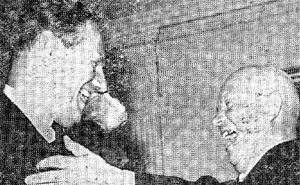
Nelson Rockefeller greets Khrushchev, the infamous "Butcher of Budapest." The Rockefeller and Eaton families have now joined forces to build war production plants behind the Iron Curtain so that the Communists can become a bigger threat to U. S. survival. America spends $70 billion a year ostensibly on defense and then the Rockefellers build aluminum mills for the Communists. Only the absence of a formal declaration of war in Vietnam keeps the Eatons and Rockefellers from being actionable for treason. They have the blood of nearly 50,000 American servicemen on their hands.
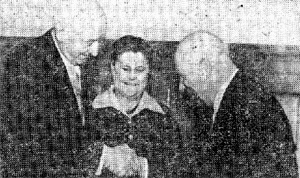 When Communist dictators visit the U. S. they do not visit the laborers or union leaders, but hobnob with industrial leaders. There is little, if any, attempt by the Red dictators to identify with the working class. Here Nikita Khrushchev greets the avowedly pro-Communist industrialist Cyrus Eaton. Eaton started his business career as secretary to John O. Rockefeller and the Rockefeller family is believed to be largely responsible for his fortune.
When Communist dictators visit the U. S. they do not visit the laborers or union leaders, but hobnob with industrial leaders. There is little, if any, attempt by the Red dictators to identify with the working class. Here Nikita Khrushchev greets the avowedly pro-Communist industrialist Cyrus Eaton. Eaton started his business career as secretary to John O. Rockefeller and the Rockefeller family is believed to be largely responsible for his fortune.
Certainly every loyal American will say to himself, "Well, I would hope to God the Soviets couldn't walk into our defense plants and buy a patent." The Rockefellers and the Eatons have solved that problem for the Communists. Now, instead of dealing with an official agency of the Soviet government, American concerns will be dealing with the Rockefellers. Meanwhile, nearly 50,000 Americans have died in Vietnam, many of them killed by weapons which the Rockefellers directly or indirectly supplied to our avowed enemies. Only the technicality of the lack of a formal declaration of war prevents the Rockefellers trading in the blood of dead Americans from being actionable as treason.
Thus by the purchase of patents for the Communists the Rockefellers are virtually in charge of research and development for the Soviet military machine, allowing the Soviets to mass produce American developments. The transfer of such knowledge is even more important than the sale of weapons. A process that may have taken an American corporation a decade to develop is transferred in toto to the Communists. Does it make sense to spend $75 billion a year on national defense and then deliberately increase the war-making potential of an avowed enemy? It does to Mr. Rockefeller and the insiders.
Since the Rockefellers have contracted to arrange for patents for the Soviets, they are by dictionary definition Communist agents. Would it not be more accurate to define the Communists as Rockefeller agents?
Indicative of this was a strange event which occurred in October of 1964. David Rockefeller, president of the Chase Manhattan Bank and chairman of the board of the Council on Foreign Relations, took a vacation in the Soviet Union. This is a peculiar place for the world’s greatest "imperialist" to take his vacation since much of Communist propaganda deals with taking all of David's wealth away from him and distributing it to "the people." A few days after Rockefeller ended his "vacation" in the Kremlin, Nikita Khrushchev was recalled from a vacation at a Black Sea resort to learn that he had been fired. How strange! As far as the world knew, Khrushchev was the absolute dictator of the Soviet government and, more important, head of the Communist Party which runs the USSR. Who has the power to fire the man who was supposedly the absolute dictator? Did David Rockefeller journey to the Soviet Union to fire an employee? Obviously the position of premier in the Soviet Union is a figurehead with the true power residing elsewhere. Perhaps, in New York.
For five decades the Communists have based their propaganda on the theme that they were going to destroy the Rockefellers and the other super-rich. Yet we find that for five decades the Rockefellers have been involved in building the strength of the Soviets. We are supposed to believe those international cartelists do this because they are foolish or greedy. Does this make sense? If a criminal goes up and down the streets shouting at the top of his lungs that as soon as he gets hold of a gun he is going to kill Joe Doaks, and you learn that Doaks is secretly giving guns to the criminal, one of two things must be true. Either Doaks is a fool or all the shouting is just "show biz" and the criminal secretly works for Doaks. The Rockefellers are not fools.
While David runs the financial end of the Rockefeller dynasty, Nelson runs the political. Nelson would like to be President of the United States. But, unfortunately for him, he is unacceptable to the vast majority of the grass roots of his own party. The next best thing to being President is controlling a President. Nelson Rockefeller and Richard Nixon are supposed to be bitter political competitors. In a sense they are, but that still does not preclude Rockefeller from asserting dominion over Mr. Nixon. When Mr. Nixon and Mr. Rockefeller competed for the Republican nomination in 1968, Rockefeller naturally would have preferred to win the prize, but regardless of who won, he would control the highest office in the land.
You will recall that right in the middle of drawing up the Republican platform in 1960, Mr. Nixon suddenly left Chicago and flew to New York to meet with Nelson Rockefeller in what Barry Goldwater described as the "Munich of the Republican Party." There was no political reason why Mr. Nixon needed to crawl to Mr. Rockefeller. He had the convention all sewed up. The Chicago Tribune cracked that it was like Grant surrendering to Lee.
In The Making of the President, 1960, Theodore White noted that Nixon accepted all the Rockefeller terms for this meeting, including provisions "that Nixon telephone Rockefeller personally with his request for a meeting; that they meet at the Rockefeller apartment … that their meeting be secret and later be announced in a press release from the Governor, not Nixon; that the meeting be clearly announced as taking place at the Vice President's request; that the statement of policy issuing from it be long, detailed, inclusive, not a summary communiqué."
The meeting produced the infamous "Compact of Fifth Avenue" in which the Republican Platform was scrapped and replaced by Rockefeller's socialist plans. The Wall Street Journal of July 25, 1960, commented: "… a little band of conservatives within the party … are shoved to the sidelines… [T]he fourteen points are very liberal indeed; they comprise a platform akin in many ways (to the Democratic platform and they are a far cry from the things that conservative men think the Republican Party ought to stand for… "As Theodore White put it:
"Never had the quadrennial liberal swoop of the regulars been more nakedly dramatized than by the open compact of Fifth Avenue. Whatever honor they might have been able to carry from their services on the platform committee had been wiped out. A single night's meeting of the two men in a millionaire's triplex apartment in Babylon-by-the-Hudson, eight hundred and thirty miles away, was about to overrule them; they were exposed as clowns for all the world to see."
The whole story behind what happened in Rockefeller's apartment will doubtless never be known. We can only make an educated guess in light of subsequent events. But it is obvious that since that time Mr. Nixon has been in the Rockefeller orbit.
After losing to Kennedy by an eyelash, Mr. Nixon, against his wishes, and at the request (or order) of Rockefeller, entered the California gubernatorial race and lost. (For further details see the author's Richard Nixon: The Man Behind The Mask.) After losing to Pat Brown in the California gubernatorial race in 1962, Nixon had universally been consigned to the political trash heap. He left his practice as an attorney in California and went to New York, where he moved in as a neighbor of Nelson Rockefeller, the man who is supposedly his archenemy, in a $ 100,000-a-year apartment in a building owned by Rockefeller. Then Mr. Nixon went to work for the law firm of Mr. Rockefeller's personal attorney, John Mitchell, and in the next six years spent most of his time touring the country and the world, first rebuilding his political reputation and then campaigning to get the 1968 Republican nomination. At the same time, according to his own financial statement, his net worth multiplied many times and he became quite wealthy. Nelson Rockefeller, (and his colleagues of the Eastern Liberal Establishment), who helped make Nixon acceptable to Conservatives by appearing to oppose him, rescued Nixon from political oblivion and made him President of the United States. Does it not make sense that Mr. Nixon, the man of passionate ambition whose career had sunk to the bottom, had to make some deals in order to reach his goal? And did he not acquire massive political debts in return for being made President by the Eastern Liberal Establishment?
When Nixon left Washington, he, by his own claim, had little more than an old Oldsmobile automobile, Pat's respectable Republican cloth coat, and a government pension. While in law practice Nixon had an income of $200, 000 per year, of which more than half went to pay for the apartment in Rocky's building. By 1968, he reported his net worth as $515,830, while assigning a value of only $45,000 to his partnership in his increasingly flourishing law firm. It may be that the frugal Mr. Nixon acquired the after-tax investment capital that mushroomed into $858,190 in assets by faithfully plugging his change into a piggy bank. Then again, it may have been part of Nixon's deal with Rockefeller and the Insiders that Mr. Nixon's personal poverty problems should be solved. The President is obviously an un-free agent.
The man most observers agree is the most powerful man in the Administration on domestic policy matters is Attorney General John Mitchell. Mitchell, who had been a Nixon law partner, served as campaign manager in 1968, and reportedly will serve in that capacity in 1972. The Wall Street Journal of January 17, 1969, revealed that Mitchell was Rocky's personal lawyer. The Establishment's landscape painters have etched a picture of Mitchell as a tough cop-type conservative bent; it appears that in reality Mitchell is but another Rockefeller agent.
Richard Nixon was elected President on a platform which promised to stop America's retreat before world Communism. Yet he appointed Henry Kissinger, a man who represented the opposite of the stands Mr. Nixon took during his campaign, to a position which is virtually Assistant President. Is it surprising then that Mr. Nixon has done just the opposite of what he promised he would do during his 1968 campaign?
How did Mr. Nixon come to pick an ultra-liberal to be his number one foreign policy advisor? We are told by Time magazine that Mr. Nixon met Kissinger at a cocktail party given by Clare Boothe Luce during the Christmas holidays in 1967. Mr. Nixon is supposed to have been so impresse4 by Dr. Kissinger's cocktail party repartee that he appointed him to the most powerful position in the Nixon Administration. Mr. Nixon would have to be stupid to have done that; and Mr. Nixon is not stupid. The Kissinger appointment was arranged by Nelson Rockefeller. (Salt Lake City Desert News, March 27, 1970) Kissinger had served for five years as Rockefeller's personal advisor on foreign affairs and at the time of his appointment he was serving as a paid staff member of the Council on Foreign Relations.
Mr. Nixon's fantastic about face was praised by LBJ in the Washington Star, Dec. 1, 1971. The paper states:
"Former President Lyndon B. Johnson acknowledges that Richard Nixon, as a Republican President, has been able to accomplish some things that a Democratic President could not have.
"'Can't you just see the uproar,' be asked during a recent interview, if I had been responsible for Taiwan getting kicked out of the United Nations? Or if I had imposed sweeping national controls on prices and wages?”
"Nixon has gotten by with it, he observed, an appreciative tone in his voice. If I had tried to do it, or Truman, or Humphrey, or any Democrat, we would have been clobbered.”
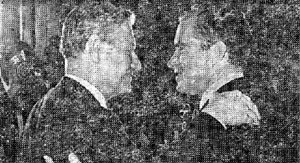 Nelson Rockefeller and Richard Nixon are theoretically political enemies, but Rocky arranged '68 election so that if he could not be President, someone whom he controlled would be. The Rockefeller family through their Chase Manhattan Bank and other entities have been great benefactors of the Soviet Union ever since Communist Revolution in Russia. During campaign Nixon promised to halt shipment of war materials from America to North Vietnam via European Communist bloc because these supplies were being used to kill American soldiers. But much of this bloc trade is controlled by Rockefellers and Nixon has reversed himself and greatly multiplied such trade. The press, quite naturally, remains silent about killing American soldiers by proxy.
Nelson Rockefeller and Richard Nixon are theoretically political enemies, but Rocky arranged '68 election so that if he could not be President, someone whom he controlled would be. The Rockefeller family through their Chase Manhattan Bank and other entities have been great benefactors of the Soviet Union ever since Communist Revolution in Russia. During campaign Nixon promised to halt shipment of war materials from America to North Vietnam via European Communist bloc because these supplies were being used to kill American soldiers. But much of this bloc trade is controlled by Rockefellers and Nixon has reversed himself and greatly multiplied such trade. The press, quite naturally, remains silent about killing American soldiers by proxy.
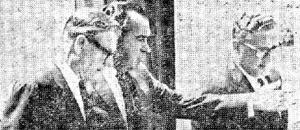 The boss and his two employees-the three musketeers of the CFR-Rocky President Nixon and Henry Kissinger confer. Kissinger of Harvard was made — virtual Assistant President by Rockefeller on whose staff he had served for a dozen years. Kissinger also had been on the staff of the CFR just prior to joining the Nixon Administration. Kissinger was the very embodiment of everything Nixon denounced during his '68 campaign. This explains why Nixon has reversed himself on so many stands. Among those to hail Mr. Nixon's move to the Left is Alger Hiss, the Communist spy Richard Nixon helped convict (Chicago Tribune, Oct. 25, 1971). It was the Hiss Case which catapulted Nixon from obscurity into the Senate, the Vice Presidency and, eventually, the White House.
The boss and his two employees-the three musketeers of the CFR-Rocky President Nixon and Henry Kissinger confer. Kissinger of Harvard was made — virtual Assistant President by Rockefeller on whose staff he had served for a dozen years. Kissinger also had been on the staff of the CFR just prior to joining the Nixon Administration. Kissinger was the very embodiment of everything Nixon denounced during his '68 campaign. This explains why Nixon has reversed himself on so many stands. Among those to hail Mr. Nixon's move to the Left is Alger Hiss, the Communist spy Richard Nixon helped convict (Chicago Tribune, Oct. 25, 1971). It was the Hiss Case which catapulted Nixon from obscurity into the Senate, the Vice Presidency and, eventually, the White House.


